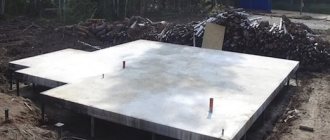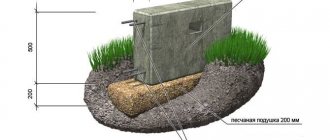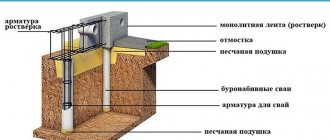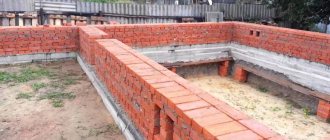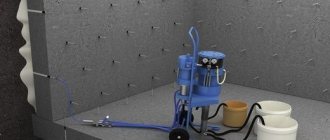Mechanism for increasing soil volume
Soil heaving is a change in its volume that occurs as a result of the freezing of groundwater contained in layers. In other words, expansion is caused by the fact that the nominal density of water in the liquid state is 1000 kilograms per cubic meter, while the density of ice is 917 kilograms per cubic meter. That is, according to the laws of physics, when transitioning from a liquid to a solid state, the volume of water increases by approximately 9%. As a result of this expansion, moisture puts pressure on the soil and the soil moves upward, since movement in the opposite direction is impossible due to the high density of the layers below.
Table: Classification of heaving of different types of soils according to GOST No. 25100.
| Types of soil | Heaving class, % |
| Soils not subject to frost heaving. Volume expansion less than 1%. |
| Soils that are slightly susceptible to frost heaving. Volume expansion from 1 to 3.5%. |
| Soils with an average tendency to heave. Volume expansion from 3.5 to 7%. |
| Soils with a high tendency to heave. Volume expansion from 7%. |
Changes in soil volumes can occur not only in winter .
For example, this process can be observed in transition periods when there are no severe frosts. Movements occur when one side of the building is constantly exposed to the sun's rays, and the other is in the shade. And if at the same time it rains, waterlogging the soil, and it begins to get cold at night, then a sharp temperature change will lead to freezing of the liquid accumulated in the ground. This can be repeated many times and lead to wear and tear of the foundation and the structure installed on it. In the spring, as a result of such exposure, the house may shrink by several centimeters. In winter, the consequences can be more critical, and the building will wear out faster and with greater damage, since the freezing force is higher during this period.
Why soil heaving is dangerous for the foundation
For foundations of any type - strip, slab and pile, not only the process of soil swelling itself is dangerous, but also the consequences of its thawing.
When winter sets in, when the temperature drops below zero and the soil freezes to a depth of one or two meters, the soil expands and begins to push out the foundation of the building. Vertical deformation of the base occurs. When a thaw occurs, frozen groundwater thaws, the soil loses its density and, under the pressure of the mass of the building, decreases to volumes several percent smaller than its original size - as a result of this, additional shrinkage of the foundation occurs.
Expert advice! The most dangerous thing for foundations is uneven soil heaving, which can be observed with different thicknesses of snow cover - the thicker it is, the higher the soil freezing limit rises and the larger its layer is subject to heaving.
Rice. 1.4 : Result of frost heaving of the soil
Construction practice shows that a specific plot of land can have an extremely complex pattern of freezing and heaving of the soil.
For example : the soil around a building located on medium heaving soil along the outer perimeter of the building can have a freezing depth of up to one and a half meters and during seasonal heaving rise up to 10 cm, while the soil located under the house will always be warmer and drier, and heaving may not be exposed at all.
This is the only way to solve the problem and prevent the building from being destroyed as a result of heaving: see
Uneven heaving can also be a consequence of the thawing of the snow cover on the south side of the building - the soil, saturated with moisture from the thawed snow, will be subject to increased heaving forces when the next frost occurs, compared to the forces on the north side of the building.
Expert advice! As a result of uneven heaving of the soil, the foundation of the building warps, the same happens to the walls of the building - as a result of the warp, cracks appear along them, the structure is deformed, loses strength and falls into disrepair.

Rice. 1.5 : An unfinished building that has fallen into disrepair due to soil heaving
Seasonal heaving poses the greatest danger to lightweight houses built from foam concrete, wood or frame panels. This is due to the inability of the pressure of the mass of the building to compensate for the buoyant loads exerted on the foundation.
A structure with a sufficiently large mass (for example, a brick house) will put pressure on the foundation, and if the pressure from the weight of the structure exceeds the buoyancy pressure of the soil, the soil, due to the impossibility of expansion, will be compacted and the effects of heaving will be weakened to a minimum.
Factors contributing to soil heaving
The main factors influencing the process of soil expansion:
- Water saturation. The higher the groundwater level in the area, the more severe the heaving manifests itself. It is necessary to lower the groundwater level if possible.
- Amount of precipitation.
- Depth of groundwater.
- Temperature and duration of frost.
- It is important to take into account the depth of soil freezing, which is different in all regions.
- Air humidity.
- Relief of the site.
- Type of soil on the site. This is an important factor, since the strength of frost pressure depends on the composition of the soil and its ability to retain moisture.
Table: Foundation depth taking into account soil types.
| Types of soils | Distance from the planning surface to the groundwater level during the freezing period | Depth of foundation from the planning surface |
| Rocky and coarse-grained soils, as well as gravelly, coarse and medium-sized sands | Any | Does not depend on the calculated freezing depth |
| Sands are fine and dusty, as well as sandy loams of fine consistency | Exceeds the calculated freezing depth by two meters or more | |
| Sands are fine and dusty, as well as sandy loams, regardless of their consistency | Less than the calculated freezing depth or exceeds it by less than two meters | Not less than the calculated freezing depth |
| Sandy loam of plastic and fluid consistency | Any | |
| Loams and clays with a hard consistency | Exceeds the calculated freezing depth by two meters or more | Does not depend on the calculated freezing depth |
| Loams and clays of soft plastic consistency | May be assigned less than the calculated freezing depth, provided that the foundation soils are protected from moisture by surface water, as well as from freezing during construction and operation | |
| Loams and clays of fluid-plastic and fluid consistency | Any | Not less than the calculated freezing depth |
| Loams and clays, regardless of their consistency | Less than the calculated freezing depth or exceeds it by less than two meters |
SGround.ru

Review article on frost heaving of soils
Table of contents:
- Introduction
- Classification of soils by degree of heaving
- Determining whether the soil is heaving or not
- Physics of the process
- Depth and speed of soil freezing
- Why is frost heaving of soil dangerous?
- Basic measures to combat heaving
- Conclusion
- Related Articles
Introduction
Heaving soil: Dispersed soil (that is, consisting of individual small particles), which, during the transition from a thawed state to a frozen state, increases in volume due to the formation of ice (GOST 25100-2011 Soils. Classification).
The freezing temperature for different soils is different, and usually ranges from 0 to -1.5 °C, and for saline soils it is significantly lower - up to minus 21 °C
The process of freezing of such soils in winter is accompanied by a vertical rise of the soil surface relative to its position in summer, and the rise of the surface often occurs unevenly. This is accompanied by the development of frost heaving forces acting on the foundations of buildings and structures. After thawing in the spring, such soils gradually decrease in volume and the soil surface returns to its previous position (subsidence).
There are also more serious phenomena associated with frost heaving, such as heaving mounds that reach enormous sizes. But they are most often characteristic of areas of permafrost and swamps of northern latitudes.
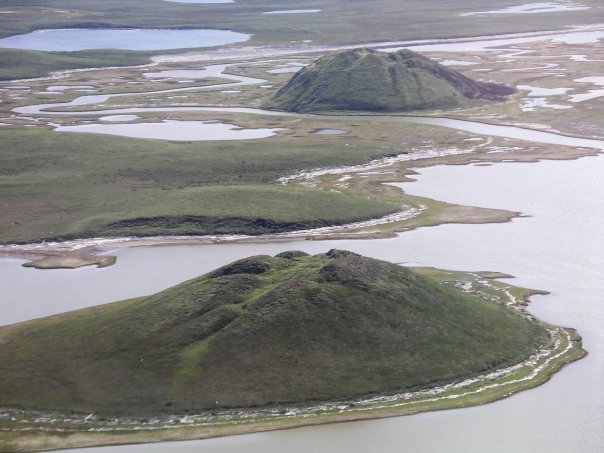
For different soils, heaving deformations are not the same and depend on the degree of moisture before freezing, the level of groundwater, the number and size of dust particles in the soil, and the depth of freezing. The maximum overall rise of the surface is achieved by the end of winter (during this period the freezing depth is maximum) and can be up to 40 cm (!), and in some cases more.
Classification of soils by degree of heaving
The classification of soils according to the degree of heaving is found in the normative literature on foundation design, in GOST for soils and in other specialized literature. The classification is slightly different in different sources, but the essence is the same everywhere. The table shows the classification based on combining data from GOST 25100-2011, GOST 25100-95, SP 22.13330.2016 and other sources:
Classification of soils by heaving according to GOST and SP
| Type of soil according to degree of heaving | Degree of heaving ɛfh, % (relative heaving deformation) | Characteristics and description of soils of this type |
| Non-heaving | · Clayey at JL · Gravelly, coarse and medium-sized sands, regardless of Sr, · Small and silty sands at Sr · Small sands containing less than 15% by weight of particles finer than 0.05 mm (regardless of the Sr value)* · Coarse-clastic with filler to 10 % | |
| Slightly heaving | 1,0-3,5 | · Clayey at 0L · Fine and silty sands at 0.6 · Coarse clastic with filler (clayey, fine sand and silty) from 10 to 30% |
| Medium heaving | 3,5-7,0 | · Clayey at 0.25L · Fine and silty sands at 0.8 · Coarse clastic with filler (clayey, fine sand and silty) over 30% |
| Highly heaving | 7,0-10 | · Clayey with JL>0.5, · Small and silty sand with Sr>0.95 |
| Excessively heaving | >10 |
* - information from GOST 25100-95 table. B.27, (in the same GOST 25100, but updated in 2011, this information is no longer available.)
Here: Sr – degree of humidity – the ratio of the natural (natural) soil moisture W to the humidity corresponding to the complete filling of the pores with water (without air bubbles); JL - soil fluidity index (determined only for clay soils and shows how much the soil is “liquefied” from moisture that has penetrated into it)
The degree of frost heaving ɛfh determines how much the soil sample increases in height when freezing. For example, when a layer of soil 1.0 m thick freezes with an ɛfh index of 7%, the soil will increase in height by 7 cm.
In this case, “non-heaving” soil will still, as a rule, increase in volume, but by an insignificant amount - less than 1%.
There is also a table that determines the degree of heaving of the soil depending on the position of the groundwater level relative to the calculated depth of soil freezing z (from the “Guide to the design of foundations and foundations on heaving soils” by N.M. Gersevanov Research Institute of Forestry and Soil Construction):
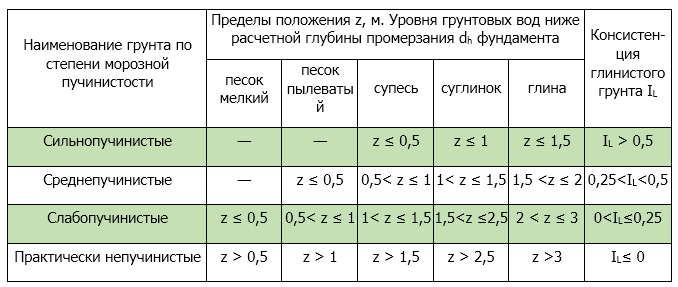
The groundwater level must be taken taking into account the forecast of its changes in accordance with the requirements of design standards.
Determining whether the soil is heaving or not
Heaving soils include clayey soils, silty and fine sands, as well as coarse-grained soils with clay and fine sand filler of more than 10%, having a moisture content above a certain level at the beginning of freezing (see table above).
This is a simpler formulation to understand:
Guaranteed non-heaving includes only:
- sands of medium coarseness, coarse and gravelly;
- crushed stone and coarse soils with clay or fine sand filler less than 10% (fills the voids between stones);
- rocky soils (water does not penetrate into them in sufficient quantities due to the lack of communicating pores, and they have high density and strength)
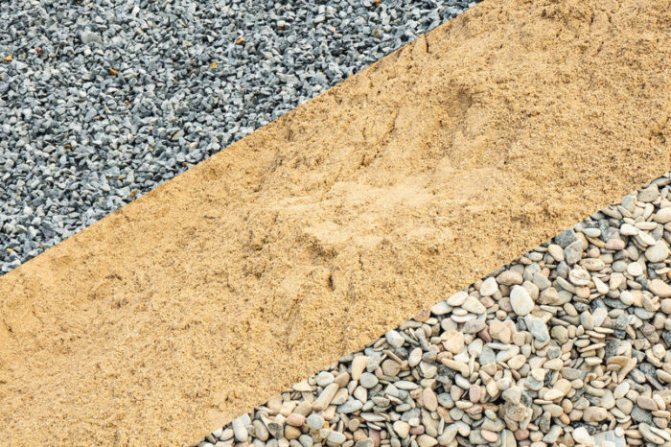
For all other soils (sandy loam, loam, clay, fine and silty sands, as well as crushed stone and coarse soils with aggregate more than 10%), the statement is true - they can be heaving , and non-heaving and this depends on:
- the amount of water in the soil (humidity) - any soil in an absolutely dry state will not show any heaving properties at all when freezing (although there are exceptions in nature), but when moistened, clay soils will have the unpleasant property that we are talking about. That is, the same soil can turn from non-heaving to moderately, strongly and even excessively heaving if it is properly moistened (rising groundwater, leaking water supply network, etc.). The higher the humidity, the more heaving will appear.
When designing foundations on foundations composed of heaving soils, one should take into account the possibility of increasing soil moisture due to rising groundwater levels, infiltration of surface water and surface screening. (SP 22.13330.2016 clause 6.8.2).
- granulometric composition of the soil - the degree of heaving increases mainly with an increase in the number (% by weight) of particles ranging in size from 0.05 to 0.005 mm. Larger and, interestingly, smaller particles have a lesser influence on the heaving index.
- The presence and proximity of the groundwater level and, accordingly, the possibility of moisture entering the freezing soil through capillaries.
How to distinguish sandy loam from sand and clay by visual and indirect signs and generally determine the type of soil, see a separate article.
Physics of the process
Why does sand not expand in volume even when saturated with water? Why do different soils have different heaving indexes?
The essence of the frost heaving process is quite complex and diverse. Many people know that when a certain volume of water freezes, ice is produced that occupies a larger volume and has a lower density (917 kg/m3). The increase in volume is approximately 9%. But frost heaving of soils is associated not only with this property of water.
When even all the pore water in the soil freezes, the increase in its volume does not exceed 3...4% (in a closed system). At the same time, in a natural occurrence, the volume of soil when it freezes increases by 10-50 and even 100%. Soil heaving reaches such indicators due to the crystallization of water in the pores of the soil and the entry of additional moisture through capillaries (migration) to the freezing front from the underlying layers that have not yet frozen (open system). This is accompanied by a sharp increase in soil moisture with the formation of ice in it in the form of lenses, layers, crystals and other structures.
Sandy soils with sufficiently large particles do not allow moisture to migrate during freezing due to the absence of narrow capillaries and a small wetting surface, but on the contrary create conditions for “squeezing” moisture towards layers that have not yet frozen, so there is practically no increase in volume during freezing even with complete water saturation. Very small particles less than 0.005 mm in size also complicate the process of moisture migration and reduce heaving
Thus, not only the initial moisture content and granulometric composition of the soil are influenced, but also its porosity, the ability to pass capillary water, the amount of bound water, chemical composition and a number of other factors.
The physics of the process is discussed in detail in a separate article.
Depth and speed of soil freezing
One of the most significant factors determining the amount of surface rise (degree of heaving) during soil freezing is the depth and speed of freezing.
The depth and rate of soil freezing depends on the negative outside air temperature in winter, on the duration of the winter period, on the thickness and density of the snow cover, the thermal conductivity of the soil, and the presence of heat-insulating coatings (there are both natural, for example, a moss or peat layer, and artificial) , the intensity of exposure to solar radiation, from changes in cold weather to thaws.
In the regulatory documentation for foundation design, only the depth of soil freezing is considered. This value is calculated using formulas depending on the average monthly temperatures during the cold season and can vary widely depending on the region and conditions: from 0 to 6 m.
The influence of the depth and rate of freezing on foundations and foundations and methods for calculating these parameters are given in detail in a separate article.
Why is frost heaving of soil dangerous?
Unfortunately, many, even experienced builders, underestimate the danger of frost heaving due to the fact that its effect does not appear immediately, is extended over time and is too difficult to predict. But in vain... After all, it is precisely the unpredictability of frost heaving that makes it mandatory .
The complexity of the heaving process and the heterogeneity of the foundation soils cause an uneven rise in the surface during freezing. The impact of frost heaving on foundations usually causes very serious negative consequences:

A crack in the foundation due to frost heaving (spring). The fence pipe has bulged, the foundation is raised 7-9 cm above the ground, after thawing in the summer it does not lower
In shallow and shallow foundations exposed to the frontal forces of frost heaving, the following occurs:
— unacceptable tilts and bending forces in strip and slab foundations, causing their damage, tilting of elements of the above-ground part of the building, cracking of walls (for walls made of rigid stone materials), etc.;
— difference in vertical deformations and unacceptable tilts for individual columnar foundations, causing damage to the above-ground part of the building, changes in the geometry of door and window openings, etc.;
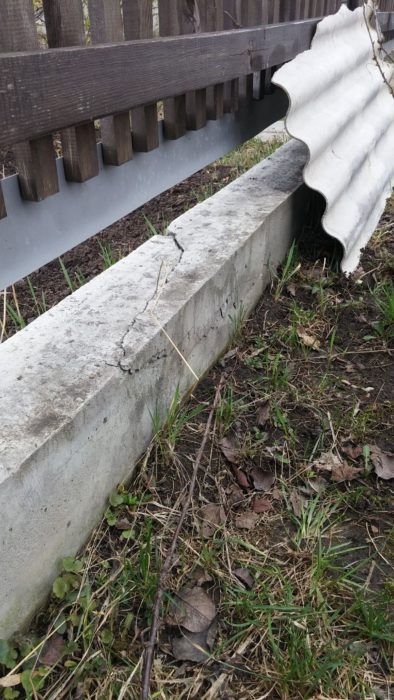
Crack in the strip foundation due to the effects of frost heaving
In pile and strip/column foundations with a depth greater than the freezing depth, the following occurs:
— lifting of pile foundations together with the soil surface under the influence of tangential forces of frost heaving. This phenomenon tends to accumulate because... After the soil thaws, the foundations do not completely lower to their original position, or do not lower at all, and in the next winter season everything repeats again.
— very large tensile forces arise between the bulging part of the foundation and the lower part, located in non-freezing layers and keeping the structure from bulging (can lead to rupture of the structure).
The danger of frost heaving lies in the uneven rise of the soil surface and in the accumulation of the heaving effect (for buried foundations) every year. During frost heaving, enormous forces arise, which are either very difficult or impossible to contain.
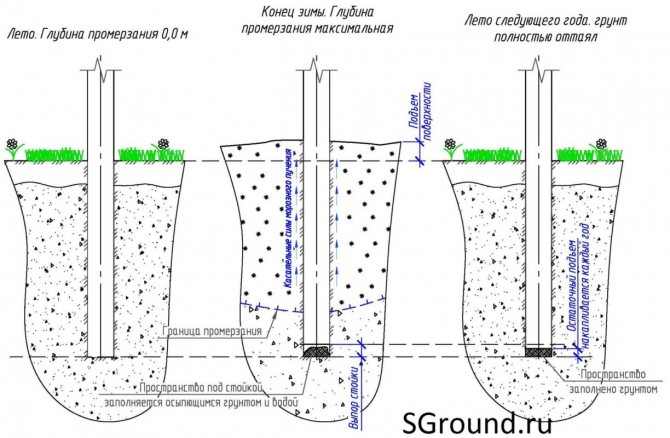
Cumulative effect from heaving of a pillar This video shows an interesting example of the effect of frost heaving on a wooden house:
Basic measures to combat heaving
The first thing that is required in the fight against frost heaving is the correct choice of foundation depth to eliminate the impact of the frontal forces of frost heaving, because These forces are of enormous importance and it is very difficult to fight them. To do this, it is necessary that the base of the foundation be below the freezing depth.
Sometimes in low-rise construction it makes sense to make non-buried or shallow foundations, assuming in advance that they will be subject to heaving, and count on them to absorb the corresponding forces. This approach is ambiguous and is not always applicable. Read separately about shallow foundations in the article.
After eliminating the frontal forces, it is necessary to cope with the remaining tangential heaving forces. Measures to combat tangential heaving forces mainly come down to the following list :
- The use of coatings on the side surfaces of piles and columnar foundations (painting, coating, shells), which reduce the forces of freezing with the soil within the freezing layer;
- The use of screw piles and piles with widening in the lower part (RIT piles, bored piles with a camouflage heel, etc.), mushroom-shaped foundations and foundations with a developed base to create high pullout resistance;
- Increasing the length of the pile based on frost heaving (so that the force holding the pile from heaving is greater than the force of frost heaving);
- Filling the pit openings with non-heaving soil (sand, ASG).
- Creating a reverse slope of the foundation faces within the freezing layer.
Supporting measures to increase the effectiveness of solutions:
— Elimination of waterlogging of soils through the use of surface runoff and drainage systems;
— Elimination or reduction of the depth of soil freezing due to surface insulation;
— The introduction of substances into the soil that reduce the freezing point of the soil (salting, impregnation with petroleum products) causes damage to the environment and is therefore rarely used.
Specific measures to combat frost heaving for different types of foundations are discussed in detail in a separate article.
Conclusion
In conclusion, we note that:
- It is possible to reliably determine the degree of heaving only through testing in the laboratory, and such tests are carried out very rarely even during engineering-geological surveys for large objects - they are more often taken from tabular data based on indirect signs: consistency, humidity, etc., and here’s why:
- If a soil sample taken at the construction site turns out to be slightly or non-heaving, this does not guarantee that it will remain so throughout the entire service life of the structure. As mentioned above, it is possible for the soil to become moist for various reasons (including heavy autumn rains) and, accordingly, for it to become heaving.
To summarize, we can say that all soils should potentially be considered heaving with the exception of a few cases :
1) at the base of the structure lies coarse or medium-sized sand, crushed stone or coarse-grained soils with aggregate up to 10% by weight.
2) rocky soils lie at the base of the structure.
3) The soils are in a dry state and there is no danger of their soaking (groundwater is absent or located at great depths (3.5 m or more below the freezing depth at the highest level of groundwater), there are all conditions for the flow of surface water and these conditions will not change in the future, there are no water-carrying communications nearby and they will never appear.
Point 3 in most cases should be questioned in the long term, because It’s impossible to say for sure what will happen in 5, 10 or 20 years.
Thus, if the soil is not guaranteed to be free of heaving, then measures should always be taken to prevent the impact of frost heaving on the foundation
And remember - if the foundation does not withstand all the loads and impacts on it, then after construction is completed, as a rule, nothing can be corrected. And the money saved on the foundation will turn into huge expenses...
Related Articles
- Depth and rate of soil freezing and their influence on heaving processes
- We determine the type and characteristics of soil by visual signs without a laboratory
- Physics of the heaving process
- Groundwater and its influence on foundation soils
- Calculations of foundations for the effects of frost heaving
- Measures to combat frost heaving
- Choosing the depth of foundations
- Non-buried or shallow foundations
- Section: normative literature
Soil pressure indicator and its effect on the foundation
This indicator means the pressure of the cobwebby soil, in particular on the foundation of the building. Ice in the ground can reach enormous masses that can push the foundation to the surface.
There are two types of buoyant action on the base of the house:
- Vertical pushing action . It occurs due to heaving of the soil layers located under the base of the building.
- Tangential buoyant action occurring as a result of heaving of the soil in contact with the side walls of the foundation.
Vertical force causes less damage to the foundation. The deformations are minor and can be prevented in advance. To do this, it is necessary to use only high-quality components for constructing the foundation, and to make the base of the structure below the freezing depth.
When exposed to a tangential force, the soil not only rises, but also delaminates. This may lead to the complete destruction of the building standing on it. This phenomenon is especially dangerous if the house has a small mass.
Schematically, the effect of buoyancy forces on the foundation of the house is presented in the following table:
| A is the pressure of the foundation on the ground. B - soil resistance. B - buoyant forces. G - tangential lateral forces. GWL —groundwater level. UPG - soil freezing level. | |
| Wrong way to lay the foundation. The foundation laid above the freezing level of the soil is pushed out by swelling forces, raising it to a height (a). | The correct way to lay the foundation. A foundation laid below the freezing level of the soil does not experience the pressure of frozen soil. |
Construction of a slab foundation
Slab foundations are divided into two types depending on the design of the slab itself, which can be flat or ribbed.
The second option is the most reliable and resistant to the loads created by the house and any soil movements, but is more difficult to construct. Therefore, if the construction conditions and the building itself do not require the creation of the most reliable foundation, you can get by with a flat option.
First stage of construction
A ribbed slab is somewhat similar to a strip foundation if you add jumpers between the sides of the perimeter and cast a solid slab on top, which will serve as the foundation for the house. The space between the lintels is filled with a mixture of sand and gravel to increase stability.
If the house is built from light material, for example, aerated concrete or wood, and has one floor and a relatively small area, then a flat slab 25 cm thick will be enough for it.
The slab is reinforced with two layers of reinforcement with a diameter of 14 mm with a grid pitch of 20 cm. This base option is excellent for small buildings on mobile and heaving soils with shallow groundwater. The load on such a slab is distributed evenly, so the house will not warp even with some particularly strong geological seasonal changes.
In addition to its main function, the slab foundation serves as insulation for the soil under the house, which will not freeze even in the most severe frosts. Also, the surface of the foundation, if it is additionally insulated and protected from moisture with a layer of waterproofing, can simultaneously serve as the floor of the house, on which boards or any other material can be laid.
The only disadvantage of a slab foundation is the high price.
With equal general parameters, it is as expensive as the tape one. But it sets quickly, does not require digging a deep trench or foundation pit, and generally takes much less time to design and construct.
The first step when building a slab foundation is to prepare the soil base. The area on which the slab will be located must be thoroughly compacted with a vibrator and leveled.
Within the boundaries of the future foundation, a small pit is dug in the form of a trough, 30-40 cm deep, no more. The bottom of the pit-trough is covered with geotextile, which is covered with a cushion of sand and crushed stone on top.
This will allow water to drain through the geotextile while the concrete and pad remain in place, held in place by the geotextile.
Also at this stage, a drainage system is created by installing trenches that need to be covered with geotextiles. Corrugated plastic pipes are laid in a cushion of crushed stone to drain water into a drain or a special well outside the building area.
Read also: Slab foundation technology, video
At this point, the preparation of the base can be completed and we can proceed to the construction of the formwork, which must be covered with dense polyethylene, otherwise the concrete may leak out through the cracks between the boards. After the formwork is erected, a reinforcing belt is knitted.
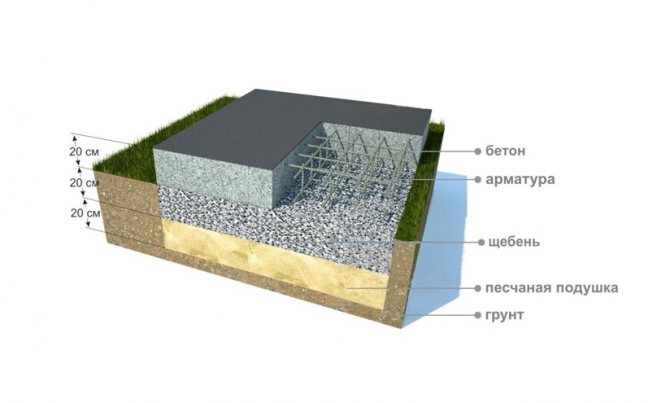
Slab foundation reinforcement
To create a reinforcing belt, two meshes of rods 14 mm thick, with a cell side of 20 cm, will be sufficient. Between both belts there should be a gap of 10 cm and a small indentation from the upper and lower edges of the foundation, 3-4 cm.
If the outer layer of concrete is smaller, it may begin to crumble and split. To do this, the bottom layer of reinforcement must be installed on metal supports, which are called “fungi”.
The top layer is supported above the bottom by vertical short rods from the same reinforcement.
Also, both reinforcing belts are connected to each other at the ends of each rod using special parts in the form of the letter P from reinforcement. The result is like a metal cage with stiffening ribs around the entire perimeter.
Under the places where the walls will pass, any columns and other supporting parts of the building will stand, another, additional layer of reinforcement is laid, taking on part of the load created by the building.
Minimizing the effects of heaving in private construction
If the soil on your site is subject to seasonal movements, then when building on such a basis, you need to take care of the continued safety of the integrity of the structures. To do this, you need to follow a few basic rules:
- You need to know the type of soil.
- Know the freezing depth for your region.
- Deepen the foundation below the freezing depth to combat buoyancy forces.
- Minimize tangential lateral forces. This can be achieved by coating the foundation with special compounds or reducing the area of lateral contact (pile foundations).
- Select the optimal type of foundation based on the design of the house and the properties of the soil on the site.
- Carry out additional measures to insulate areas close to the foundation. In this case, the soil around the house is insulated, which prevents freezing.
- Combat artificial waterlogging of the soil. To do this, a blind area is constructed to protect the foundation of the house from precipitation. You can also use a drainage system (a more expensive solution).
Any of these methods is effective in combating frost heaving of the soil. And their combination will only enhance the effect. When starting to build a house, take care of this in advance and minimize the undesirable consequences of possible deformations of the foundation.

Construction of a monolithic slab
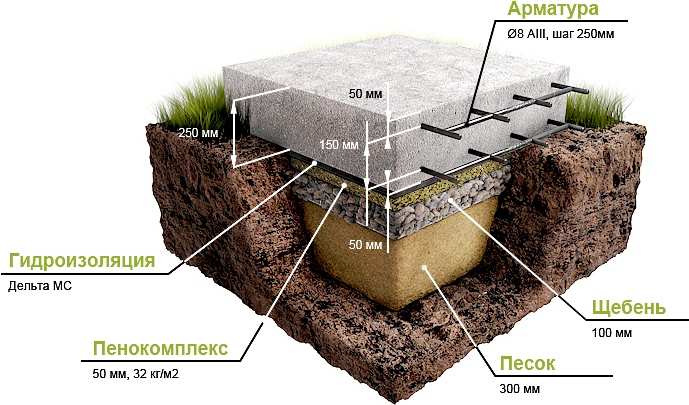
This foundation is considered as a non-buried type of foundation. It is installed on heaving soils in the following cases.
- During the construction of heavy brick houses, when the weight of the building balances the pushing loads and gives additional stability.
- When to use the “floating” feature of the slab: when constructing houses with low weight.
A monolithic slab is called a floating structure due to its ability to lower and rise with changes in the ground. Due to the fact that the ground under the house freezes unevenly, a difference in the plane is formed during subsidence, which can reach 10 cm or more.
Therefore, this type of base implies special requirements for bending resistance. For this purpose, reinforced reinforcement and the creation of a thicker slab are used.
When laying a slab on low-density and subsidence soils, it is insulated with a ten-centimeter layer of EPS. The use of insulation and a layer of sand bedding up to 0.5 m will ensure uniform freezing of the ground under the entire area of the building. Therefore, a hole will not form in the middle of the slab.
The large support area will significantly reduce the specific loads on the ground.
- The construction of a slab foundation for a private household is reasonable if the bearing capacity of the soil at the construction site is weak.
Measures against soil heaving
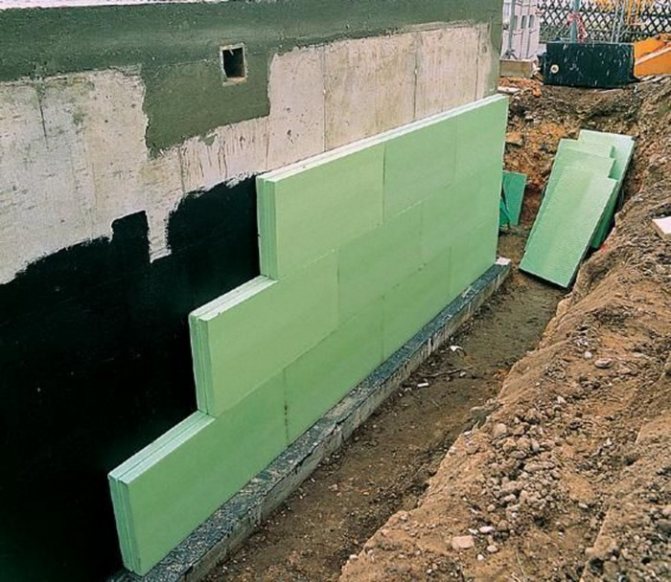
It is possible to efficiently and reliably insulate the foundation from all sides, this will reduce the percentage of the negative impact of frozen soil on the base
If the house has already been built and the foundation needs to be further protected, then the following methods and techniques can be used:
- Around the finished foundation, you can completely replace the soil with non-heaving soil. To do this you will have to do a lot of excavation work, but the result is worth it.
- It is possible to efficiently and reliably insulate the foundation from all sides. This will reduce the percentage of the negative impact of frozen soil on the base.
- High-quality blind areas and storm drainage running from the base of the house will help drain water and thereby reduce the amount of liquid in the soil. This means that soil heaving will be reduced.
All these construction methods and technologies make it possible to build durable and strong houses on demanding soils.
Monolith
The formation of a slab structure will make the building heavier, which, in turn, will minimize the impact of the soil on the foundation. Of course, it will not be possible to completely eliminate the influence of frost heaving on a monolithic slab with a height of more than 200 mm, recessed into the ground. At the same time, as a result of soil heaving, the foundation will simply rise evenly to a low height in winter. With warming, the foundation will return to its original position.
From a technical point of view, the implementation of a slab foundation is not difficult. Certain difficulties usually arise during the reinforcement operation. In addition, this method is quite expensive.
Insulation of the perimeter of the house
This method allows you to minimize or completely eliminate soil freezing. By insulating the soil, it is possible to build a shallow foundation due to a decrease in the freezing depth.
Only this option for combating soil heaving is relevant for areas with positive average annual temperatures. The width of the installed insulation should be equal to the freezing depth of the soil. As for the thickness of the material, it all depends on the thermal insulation properties and the nature of the climate.
Soil replacement procedure
This method only works when laying a foundation - a sand cushion is placed under the base. Moreover, it should be noticeably wider than the foundation of the building itself. Then it is well compacted and compacted. Thanks to this cushion, the entire load on the base is evenly distributed. In addition, the layer of heaving soil decreases, therefore, the strength of the natural phenomenon also becomes weaker. In addition, the sand cushion has shock-absorbing properties.
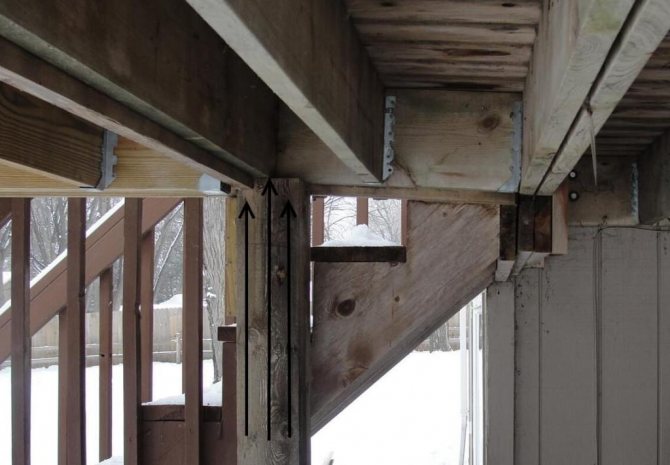
In addition, experts recommend filling the area between the formwork after its removal and the soil with non-heaving soil to avoid deformation from soil heaving. This measure will prevent the soil from freezing to the foundation walls.
Only after some time can the sand in the backfill (including the cushion) mix with clay particles, losing its non-heaving properties. To avoid this, the sand bed and backfill should be separated by film, roofing felt or filter fabric.
Feature of a natural phenomenon
The main feature of the heaving process is a significant increase in the volume of water in the soil due to winter freezing. According to GOST 25100-2011, there are 5 categories that differ in the degree of heaving (the level of soil expansion is indicated in parentheses):
- Excessively heaving soils – more than 12%.
- Highly heaving soils – no more than 12%.
- Medium heaving soils – up to 8%.
- Low heaving soils – approximately 4%.
- Non-heaving soils – does not exceed 4%.
However, the last category should be considered conditional, since in nature there is simply no soil where there is a complete absence of moisture. Only granite and coarse soil rocks should be classified as this type. However, in our conditions this type of soil is quite rare.
Piles
The installation of a pile foundation will allow you to get by with little expense. Only this design is applicable only to buildings with low weight (construction using frame technology, the use of sip panels, etc.).
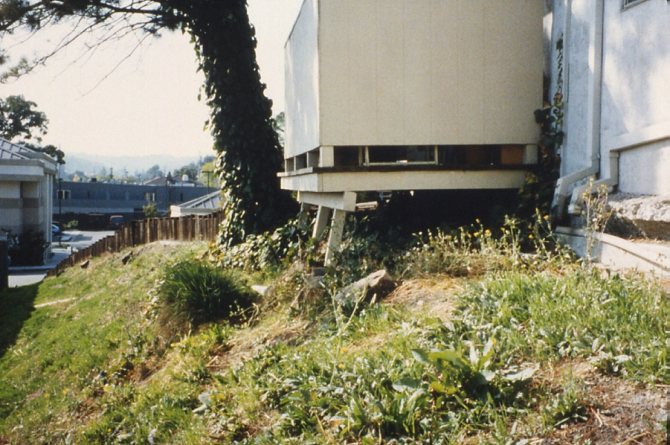
The following options may be suitable for the base:
- Screw piles - they are screwed into the ground slightly below its freezing level.
- Reinforced structures - you first need to prepare several wells, and then install rods in them, wrapped in roofing felt and wrapped with a metal frame.
After the piles are installed, they should be connected with special beams or slabs to evenly distribute the load on the foundation.
Construction and structural methods

Pile foundation
You can combat heaving by adapting the foundation design to difficult conditions. Such measures are justified when it is impossible or very expensive to cope with the effects of heaving in other ways.
Construction of a pile foundation
Pile foundation is a common option for frost-hazardous soils. The supporting elements for it are metal, concrete and reinforced concrete. According to the installation method, they are divided into:
- screw;
- driving;
- printed.
The piles are installed at a depth below the freezing point, which neutralizes the effect of vertical swelling. The most widespread are screw elements, characterized by affordable cost and speed of installation.
Correct depth

The foundation mark on clay soil and loams should be below the freezing level. The indicator for all regions of Russia can be found in a special reference table. The opposite option is a shallow foundation. The structure does not resist heaving forces, but moves with them. This type of base is called floating. They are laid at a shallow depth - from 30 to 70 cm.
Structure processing
The side surface of the columnar base and basement walls is coated with a special compound that reduces soil freezing. This can be bitumen mastic, substances that form a polymer film, or roofing felt. A smooth surface without roughness is less susceptible to adhesion to the ground. The procedure allows you to reduce the tangential effect of heaving forces.
Frost heaving negatively affects structural parts of buildings, causing deformation and damage. To reduce repair costs, it is necessary to take measures in advance to protect the foundation from heaving soil.
How to reduce soil heaving at the base of the foundation
It is often beneficial to strengthen the soil, which will allow for a simple and reliable foundation. For highly heaving soils, it makes sense to focus primarily on improving soil characteristics
base, and only then on calculating the thickness-width of the foundation strip and its reinforcement.
To reduce soil heaving deformations, the following measures are usually taken:
1. A good option for solving the problem of stabilizing heaving soils may be to construct an embankment from non-heaving soil
and the construction of the foundation is already on it. In this case, two problems are solved: the general level of the local area is raised (this is usually true for such soils) and the soil parameters are improved.
2. Partial or complete replacement of the heaving layer
non-heaving by creating pillows of coarse or medium sand with a high filtration coefficient.
3. Reducing soil moisture
(by using geotextiles to reduce capillary suction, drainage devices, clay castles and blind areas, lowering the groundwater level, draining surface water from the building through vertical planning, drainage ditches, trays, trenches, drainage layers, etc.).
4. Soil insulation,
for example, the installation of a thermally insulated shallow foundation (TFMZ).
Main provoking factor
At first glance, it seems that the damage from heaving may not be so huge, but it only seems so. To understand the full threat from such a natural phenomenon, it is worth clearly understanding how this process occurs.
As we now know, the phenomenon is characterized by heterogeneity, which is mainly due to differences in the height of the earth's surface. As a rule, this is observed in the spring - the side of the building that is located in the south is well heated. In addition, spring drops make their contribution. As evening approaches, a large amount of melt water accumulates in the ground, which then becomes ice.
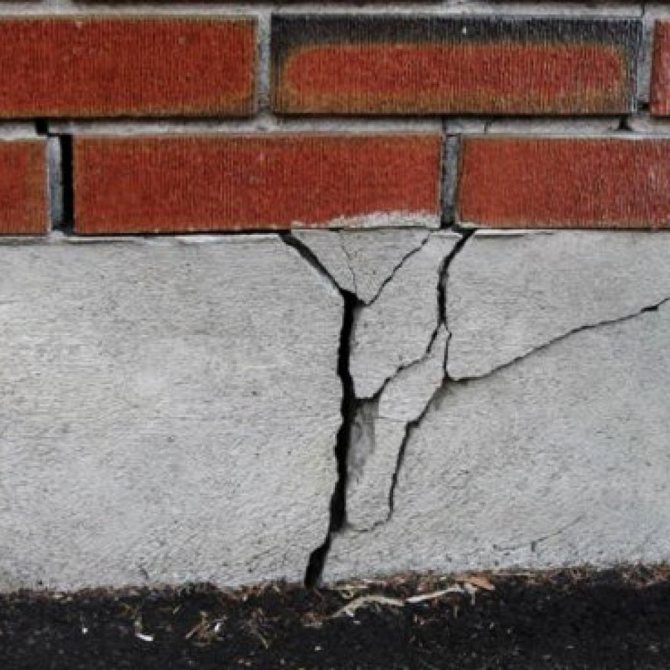
The mass of this layer can reach several centners, and this is already quite enough to raise the foundation to a certain height. This process takes all night.
During the day, the opposite picture is observed - as the temperature rises, the ice in the ground begins to thaw. Accordingly, the foundation begins to sink, and at the same time the earth is again enriched with another portion of water, which then crystallizes again. All this happens day after day until the temperature returns to normal.
During the spring period of water level changes, the building may drop several centimeters. This is quite enough to cause serious damage, which will later be very difficult to correct, if it can be done at all.
